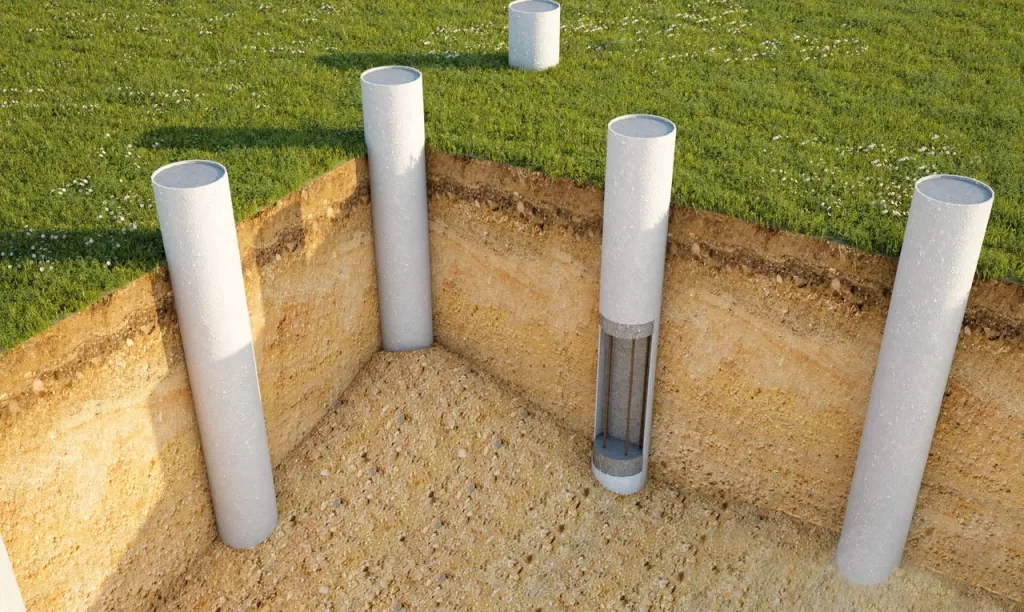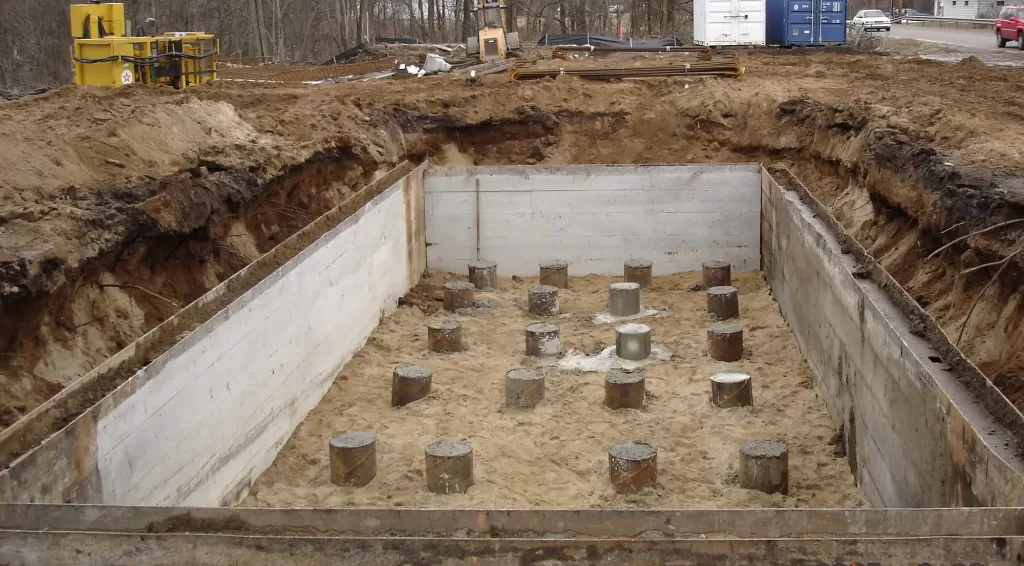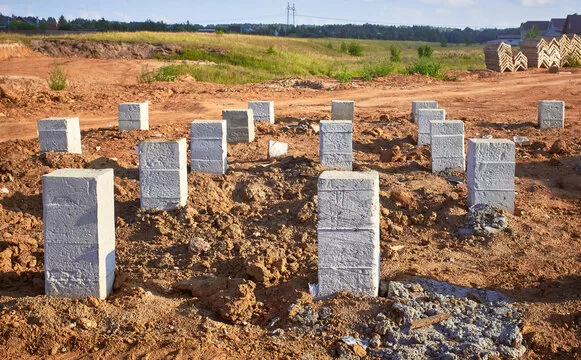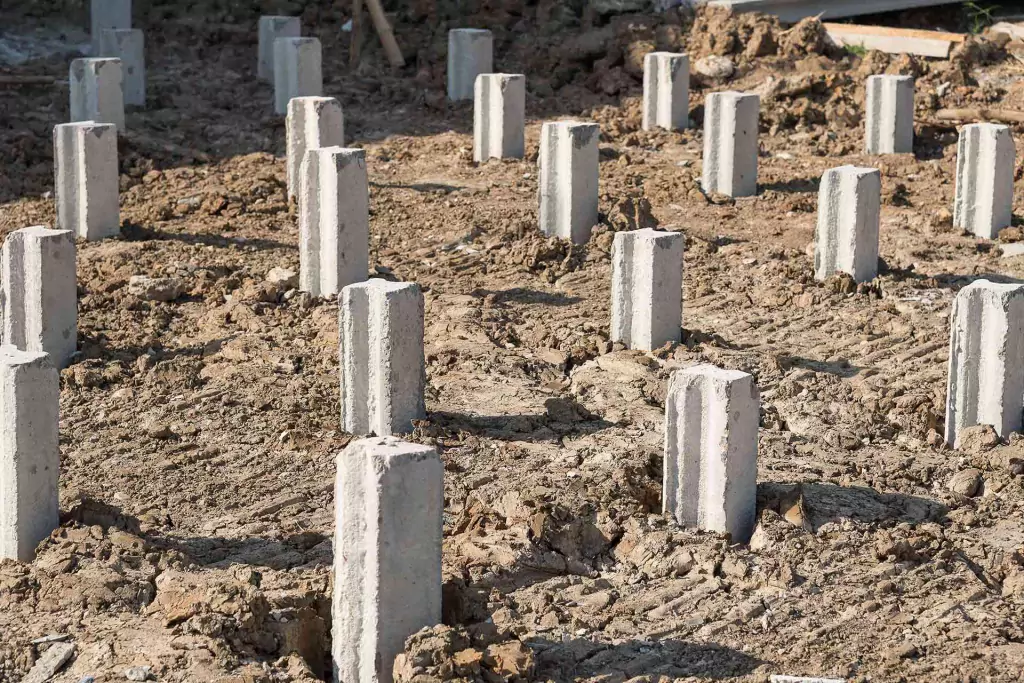Foundations are pivotal components of structures, divided into two fundamental categories: shallow foundations and deep foundations. Shallow foundations find application when the load exerted by a structure remains modest in comparison to the bearing capacity of surface soils. On the other hand, deep foundations come into play when the surface soils’ bearing capacity is inadequate to support the imposed loads, necessitating the transfer of loads to deeper layers with enhanced bearing capacity.
Utilization of Pile Foundations
Pile foundations serve as a primary means to convey loads from superstructures through weak, compressible strata or water to more robust, denser, less compressible, and stiffer soil or rock strata at greater depths. This mechanism enhances the effective footprint of a foundation, effectively resists horizontal forces, and frequently accommodates larger structures. Pile foundations find preference in situations where the existing soil conditions are unsuitable to prevent excessive settling.
Due to the substantial load-bearing role that pile foundations undertake, their design requires meticulous attention. Skillful engineers carefully analyze the soil surrounding the piles to ensure that it remains within its bearing capacity limits, averting overloading.
Each pile’s influence radiates through the adjacent soil. The spacing between piles is critical to distribute loads uniformly across the entire area of soil supporting them, preventing concentration of forces in specific regions.

Instances for Employing Pile Foundations
- High Groundwater Table: Pile foundations are particularly useful when the water table is elevated, as traditional shallow foundations might lead to excessive settlement due to soil saturation.
- Varied Superstructure Loads: When dealing with uneven or substantial loads from the superstructure, pile foundations offer a reliable means of distributing these loads effectively.
- Economic Considerations: In situations where alternative foundation types are either cost-prohibitive or infeasible, pile foundations can present a viable solution.
- Compressible Shallow Soil: When the shallow soil layers are prone to substantial compression, pile foundations bypass these weaker strata to reach more stable substrates.
- Proximity to Water Bodies: Pile foundations prove advantageous near water bodies prone to scouring, as they mitigate the impact of erosion.
- Adjacent to Canals or Deep Drains: Structures positioned alongside canals or deep drainage systems often necessitate pile foundations to ensure stability.
- Challenging Soil Excavation: Pile foundations become essential when soil excavation to the desired depth becomes impractical due to poor soil conditions.
- Excessive Seepage: Pile foundations are a recourse when heavy seepage inflow makes it difficult to maintain dry foundation trenches using conventional methods.

Types of Pile Foundations
End bearing piles
End bearing piles are a type of deep foundation that primarily relies on the load-bearing capacity of the soil or rock layer at its bottom. These piles are designed to transfer the loads from superstructures to a stronger and more supportive layer of soil or rock that lies beneath weaker or less competent soil layers near the surface.
The fundamental principle behind end bearing piles is to ensure that the bottom end of the pile comes into direct contact with a robust stratum of soil or rock that can effectively support the loads applied by the structure above. This stratum, known as the “bearing stratum,” typically possesses higher strength and greater load-bearing capacity compared to the upper layers of soil.
Friction Piles
Friction piles, a type of deep foundation, derive their load-bearing capacity from the frictional resistance created along the length of the pile shaft as it interacts with the surrounding soil. Instead of relying on a stronger stratum at the pile’s base, friction piles utilize the adhesion and friction between the pile surface and the soil to transfer loads from superstructures. The effectiveness of friction piles is prominent in cohesive soils where adhesion and friction are substantial, although their efficacy can be reduced in granular soils. The load applied to a friction pile is distributed along its shaft, gradually decreasing from the superstructure to the tip. These piles are particularly advantageous when a consistent and robust load-bearing capacity exists in the surrounding soil. Proper pile installation techniques are essential to maximize frictional resistance, requiring careful consideration of pile driving or drilling methods. Friction piles offer an efficient solution where end bearing is not feasible, effectively ensuring load transfer and structural stability within construction projects.

Driven piles
Driven piles represent a fundamental type of deep foundation used to transfer structural loads from superstructures to the underlying soil or rock layers. These piles are installed through impact or vibration, typically using specialized equipment such as pile drivers or vibratory hammers. The installation process involves driving the pile into the ground, displacing soil and compacting it around the pile shaft. Driven piles gain their load-bearing capacity by mobilizing the soil’s resistance, effectively transferring the loads through displacement and compaction.
One of the key advantages of driven piles is their adaptability to various soil conditions, making them suitable for a wide range of projects. They can be composed of materials such as concrete, steel, or timber, depending on load requirements and environmental considerations. Driven piles are extensively used for a variety of structures including buildings, bridges, retaining walls, and industrial facilities. Proper installation is critical for maximizing their effectiveness, considering factors like pile type, soil characteristics, and driving techniques. The performance of driven piles relies on accurate geotechnical assessments, ensuring that the chosen piles and driving methods are tailored to the specific site conditions.
Bored piles
Bored piles, a crucial type of deep foundation, serve the purpose of transferring structural loads from superstructures to the underlying soil or rock layers. These piles are formed through a process of excavation and subsequent installation of reinforced concrete. The process involves drilling a hole into the ground using specialized equipment like augers or drilling rigs, followed by the insertion of reinforcing steel bars and the pouring of concrete into the excavated hole. The concrete replaces the excavated soil, creating a columnar foundation element.
Bored piles are particularly advantageous when dealing with cohesive soils or near existing structures, as they generate minimal vibration and allow for precise positioning. Their versatility makes them suitable for a variety of construction projects, including high-rise buildings, bridges, and infrastructure. Their load-bearing capacity is derived from the combination of the concrete and the friction between the pile and the surrounding soil.
A crucial aspect of bored pile construction is accurate drilling and concreting to ensure proper load transfer and structural stability. Geotechnical investigations play a pivotal role in determining the suitability of bored piles for a specific site. The method provides the advantage of controlling the spoil material and reducing the potential for soil disturbance. Bored piles are integral to modern construction, offering a reliable foundation solution that caters to various soil conditions while minimizing disruption and ensuring long-term structural integrity.
Screw pile
Screw piles, a specialized type of deep foundation, are designed to provide load-bearing support by screwing into the ground rather than being driven or bored. These piles consist of a helical or spiral plate, often referred to as a “screw,” attached to a central shaft. The helical plate allows the pile to be rotated into the soil, creating both vertical and lateral support. Screw piles are an efficient foundation solution, especially in areas with challenging soil conditions or limited access.
The installation of screw piles involves rotating them into the ground using hydraulic motors or other specialized equipment. As the helical plates advance into the soil, they generate both axial and lateral load resistance. Screw piles are advantageous in various scenarios, including locations with variable or weak soil, areas prone to seismic activity, and environmentally sensitive sites where minimal soil disturbance is crucial.
The load-bearing capacity of screw piles depends on factors such as the helix configuration, pile length, soil type, and installation torque. These piles offer ease of installation, reduced environmental impact, and immediate load-carrying capacity, making them a popular choice for a wide range of applications, including foundation support for structures, boardwalks, retaining walls, and solar panels. Screw piles exemplify innovation in foundation engineering, providing a reliable and sustainable alternative for challenging soil conditions while ensuring structural stability.

Timber piles
Timber piles are a traditional yet enduringly effective form of deep foundation used to support structures by transferring their loads from superstructures to the underlying soil or rock layers. These piles are constructed from wood, often driven into the ground using impact or vibration methods. Timber piles derive their load-bearing capacity from both the natural strength of the wood and the friction generated between the pile and the surrounding soil.
Timber piles are advantageous for various reasons. They are economical, readily available, and can be easily modified on-site to suit specific load requirements. Additionally, timber piles are environmentally friendly, as wood is a renewable resource. However, their effectiveness can vary based on factors such as the type of wood used, soil conditions, and potential vulnerability to decay or insect damage. Proper treatment and protection against these threats are essential for maintaining the durability of timber piles.
These piles are commonly used in both permanent and temporary structures, such as houses, piers, docks, and foundation systems. The simplicity of timber pile installation makes them a practical choice for various applications. While modern construction often utilizes other materials, timber piles remain a viable and dependable foundation option, combining cost-effectiveness with reliable load transfer and contributing to the sustainability of construction practices.
Steel piles
Steel piles are a versatile and robust type of deep foundation that effectively supports structures by transferring their loads from superstructures to the underlying soil or rock layers. Composed of high-strength steel, these piles are installed through driving methods, utilizing impact or vibration, which displace the soil and compact it around the pile shaft. Steel piles derive their load-bearing capacity from both the inherent strength of the material and the friction generated between the pile and the surrounding soil.
One of the key advantages of steel piles is their exceptional strength and durability, making them suitable for a wide range of projects, including heavy industrial facilities, bridges, and offshore structures. Their high load-carrying capacity and resistance to environmental factors contribute to their reliability in various soil conditions.
Steel piles come in various shapes and sizes, allowing engineers to tailor them to specific project requirements. They can be driven to substantial depths, providing reliable support even in challenging soil conditions. However, considerations such as corrosion protection and potential environmental impact need to be addressed through proper coating and design.
Due to their strength and adaptability, steel piles remain a preferred choice in modern construction for critical structures that demand durability, stability, and longevity. Their versatility, combined with advancements in coating technologies, ensures that steel piles continue to play a crucial role in supporting a wide range of construction projects.
Concrete piles
Concrete piles serve as a vital form of deep foundation, integral in transferring loads from superstructures to the underlying soil or rock layers. These piles are formed by pouring concrete into pre-dug holes or excavations, allowing the concrete to replace the displaced soil. The load-bearing capacity of concrete piles arises from both the inherent strength of the material and the interaction between the concrete and the surrounding soil, which contributes to frictional resistance.
Concrete piles offer several advantages, including their durability, strength, and resistance to corrosion and decay. They are well-suited for various projects, from residential buildings to large-scale infrastructure, such as bridges and piers. Different types of concrete piles, like precast or cast-in-place, cater to diverse construction requirements.
The use of concrete piles provides engineers with the flexibility to adapt pile designs to specific load demands, soil conditions, and environmental considerations. However, the installation process requires careful attention to factors like pile alignment, concrete quality, and site conditions to ensure proper load transfer and long-term stability.
Modern construction practices often incorporate innovations in concrete mix design and reinforcement, enhancing the performance and longevity of concrete piles. With their reliable load-carrying capacity and adaptability, concrete piles continue to be a cornerstone of foundation engineering, supporting safe and durable structures across a range of construction projects.

Conclusion
Deep foundation systems play an indispensable role in modern construction, offering effective solutions for transferring structural loads to the underlying soil or rock layers. Whether using end bearing piles that rely on robust strata at their base, friction piles that harness soil adhesion and friction, or innovative options like screw piles, the selection of the appropriate foundation type hinges on factors such as soil conditions, load requirements, and site constraints.
Driven, bored, and other installation methods further amplify the adaptability of deep foundations, ensuring stability and long-term performance. Each method offers distinct advantages, addressing specific challenges such as soil disturbance, environmental impact, and the need for minimal vibration in sensitive areas.
While technology and engineering continue to evolve, the core principles of deep foundation design and installation remain constant – to establish a secure and reliable platform for diverse structures, from towering skyscrapers to essential infrastructure. By tailoring foundation solutions to site-specific conditions and utilizing advanced materials and techniques, construction professionals uphold the integrity of our built environment and ensure the safety and stability of structures that shape our world. Deep foundations stand as a testament to the harmonious coexistence of engineering ingenuity and the earth’s underlying support, laying the groundwork for a resilient and enduring future.


